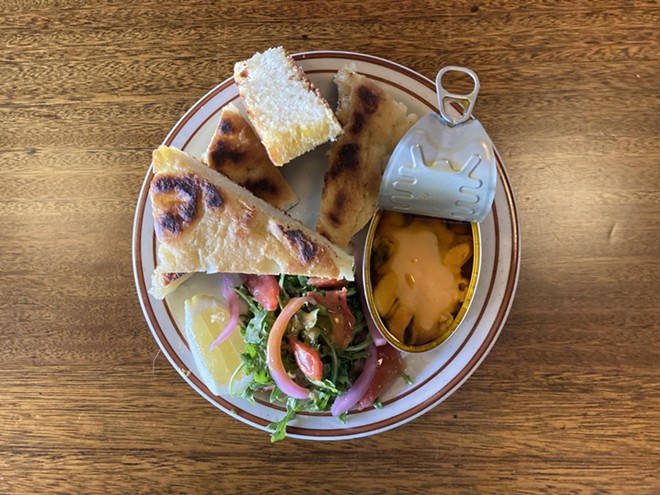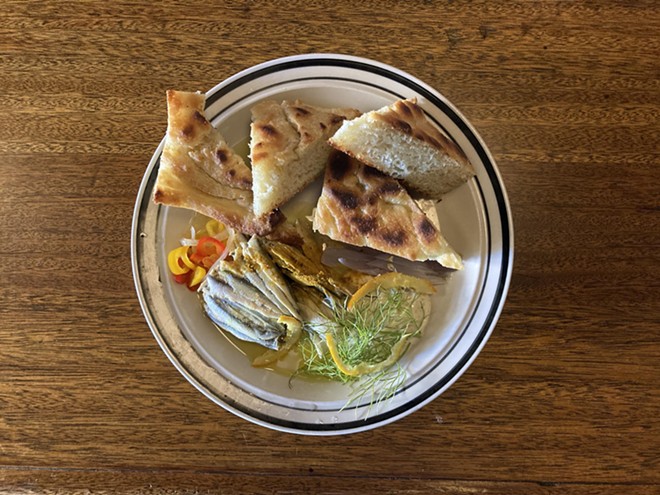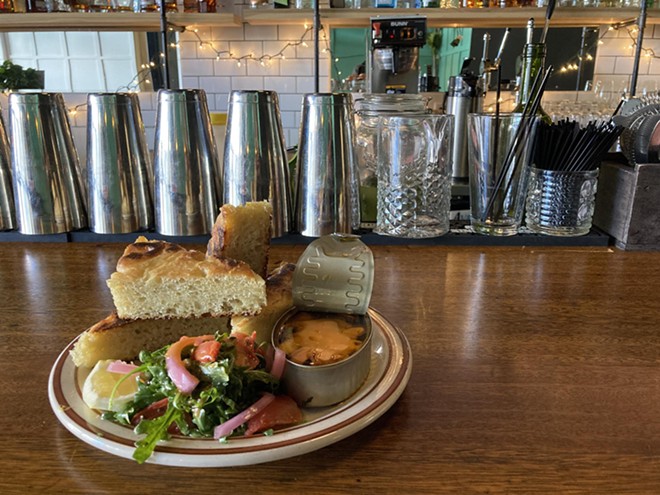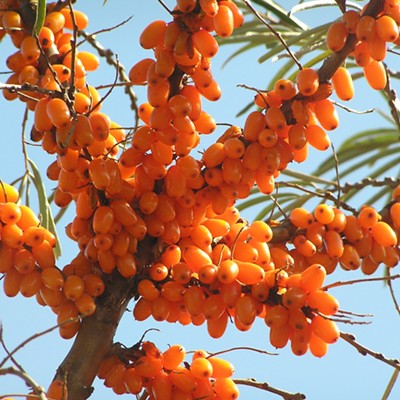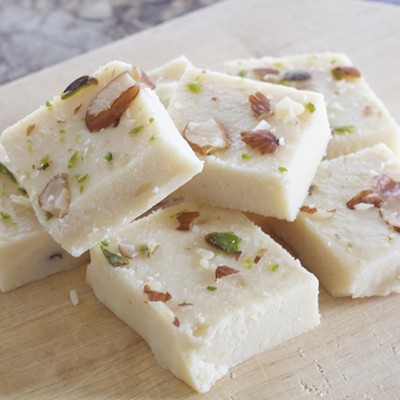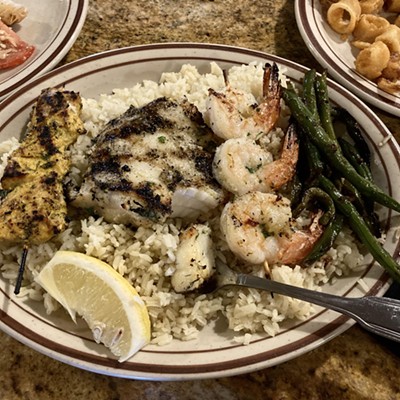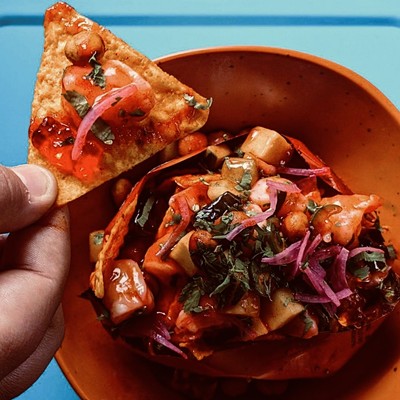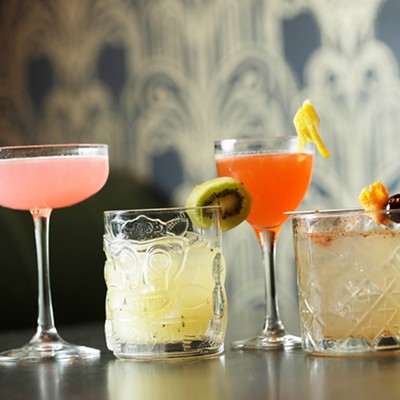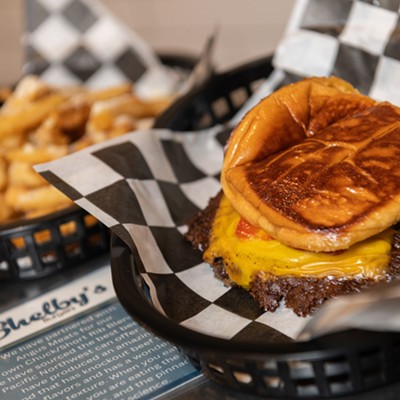Around the World in 80 Plates: Tinned seafood from Spain
[
{
"name": "Broadstreet - Instory",
"insertPoint": "5",
"component": "25846487",
"requiredCountToDisplay": "5"
},{
"name": "Broadstreet - Instory",
"insertPoint": "10",
"component": "25846487",
"requiredCountToDisplay": "10"
},{
"name": "Broadstreet - Instory",
"insertPoint": "15",
"component": "25846487",
"requiredCountToDisplay": "15"
},{
"name": "Broadstreet - Instory",
"insertPoint": "20",
"component": "25846487",
"requiredCountToDisplay": "20"
}
]
This is an installment of the Inlander's yearlong project "Around the World in 80 Plates," a quest to find 80 foods and drinks in the Spokane area representing 80 different places. Read the introduction to the project here.
Count of dishes/places: 22
I have two words for you: tinned seafood.
I'm not just talking tuna. I'm talking sardines, anchovies and mackerel. Mussels and octopus, even.
Tinned fish has finally been having its moment and I could not be more thrilled. Normally, I hate food trends on social media, but no one else has taken up the task of giving the tiny fin tin the hype it deserves. (I've never actually heard it called a "fin tin," but now that I've written it I'm determined to make it a thing. YOU HEARD IT HERE FIRST, FOLKS.)
Palates are personal, I get it. But the bad rap that tinned fish gets in the U.S. is bonkers. Everyone else in the world loves it. It's high time to cancel the American narrative that sardines or anchovies are scary. It's childish, and it keeps our food from tasting good.
Preserved seafood has been the secret to delicious food ever since an ancient fisherman caught too many tiny fish on a hot day. Pack those fish in salt or oil, and you've got an unstoppable umami flavorblast for your next dish.
If you like Caesar salad, thank the anchovies. If you like Thai or Vietnamese food, thank the fish sauce. If you like adorable date ideas, thank self-proclaimed "tinfluencer" Ali Hooke for the cute tasting boards of tinned seafood, thin crackers and white wine for date nights with her husband.
Other reasons for hype: tinned seafood is pretty cheap. It's good for you (small fish like sardines don't have high levels of mercury, despite the rumors.) It's good for the planet. The packaging is effing adorable. It comes in endless varieties, packed in things like olive oil, tomato sauce, lemon juice and salt water.
And a whole collection of imported tinned fish are featured on Ruin's happy hour menu from 3 pm-5 pm.
For $12, chefs Tony Brown and Peter Adams pair each type of tinned seafood with exactly the right condiments — some pickled onion, curry aioli, a sprig of dill — whatever makes that specific fish or shellfish shine. All you have to do is pile it on top of a pillow of Ruin's to-die-for focaccia. (The server *apologized* that they didn't have crackers. I was not disappointed in the slightest.)
Salty. Creamy. Zesty. Fluffy. Need I say more?
But somehow, this happy hour has not caught on. This is your chance, Spokane. Hop on the fin tin bandwagon. Get under the tin-fluence. Go tin-sane.
If you like liquor or black coffee or cigars or any other "acquired taste," you can fall in love with tinned seafood. Even if you just like pickles, chances of you liking sardines are wonderfully high.
So get "trendy" and take on the tastiest food challenge yet. (Except for the fact that it's actually a centuries-old tradition that's commonplace in almost every other country...but, you know, "American exceptionalism" and all that.)
SPANISH WHITE ANCHOVIES FROM THE CANTABRIAN SEA
Imagine waiting for dinner at golden hour in a Spanish vineyard, or at a swanky late night bar in Barcelona, with a few tapas and a glass of wine. One of the small plates is probably a platter of boquerones, or Spanish white anchovies, caught in the Cantabrian Sea between Spain and France. They're some of the most highly sought after anchovies in the world.
The Marine Conservation Society recommends eating sardines caught in the Cantabrian Sea, because populations are plentiful and fishing management by Spain and Portugal continues to improve.
From 2005 to 2010, the Cantabrian anchovy fleet was shut down to let anchovy populations increase after years of unsustainable fishing. But by 2015, the fleet cooperated with the Marine Stewardship Council to improve practices and become the first European anchovy fishery to be MSC certified. Out further in the Bay of Biscay, however, overfishing continues to be an issue. A quick glance at a label, though, should let you know if the boquerones are MSC certified or not.
Instead of being packed in salt, Spanish anchovies are marinated in vinegar, which give them a clean, white color. They're filleted the same day they're caught, preserved in the acid, then packed in olive oil and herbs when they're ready to be eaten.
A far cry from the brown, slimy anchovies that inch across pizza lovers' nightmares, boquerones have plenty of fluffy meat for so small a fish. They're thick, briny and bright, typically pairing well with a white wine.
At Ruins, Brown and Adams serve the boquerones with a lemon, dill, and curried aioli. It's a blast of Mediterranean sunshine on a cloudy Northwest day, a light snack that won't ruin your dinner but doesn't skimp on flavor. So ditch work an hour early and enjoy the little things in life. A little plate. A little wine. A little moment alone, or together. And a tiny, tasty, tinned fish.
TINNED MUSSELS FROM GALICIA, SPAIN
Evidence of mussel eating in Galicia, an autonomous region in northwestern Spain, dates back to the 8th century BCE. But it wasn't until 1945 that the first raft floated on the Ría de Arousa, the largest of five estuaries in Galicia. An estuary is where a freshwater river meets the salty sea, an ecosystem that provides some of the best breeding grounds for mussels, clams, oysters, scallops and other marine life.
The Ría de Arousa might be the largest mussel producing area in the world. In medieval times, it was also vulnerable to invasion, which means watchtowers from the 11th century overshadow the modern shellfish farming that now happens in the rich saline waters.
There, rafts sit on top of the water with 40 foot ropes hanging down into the deep, underwater valley. Mussels spawn and grow on the ropes, which are then pulled up after a year or so for harvest. Galicia has about 1200 km of coastline available to mussel production. The Ría de Arousa alone has over 2000 rafts, or bateas, cultivating mussels.
Many mussels are served fresh or steamed in local or high end seafood restaurants. But some are tinned with olive oil and vinegar and shipped across the world for anyone to enjoy. That's great news for landlocked cities like Spokane.
The tinned Galician mussels served at Ruins are salty and sweet, but decidedly light — much lighter and less obtrusive than anchovies or sardines. The mussels disintegrate in your mouth more quickly — almost indiscernibly, if you add some of the pickled onion and mizuna that comes on the side. It's a quick crunch of spring vegetables and then a kiss from the ocean.
So, now that spring is here, the light is lingering longer, and dinners are getting pushed later (almost to an acceptable hour for Europeans), celebrate the bounty of Western Spain from West Riverside Avenue. Expand your palate, and your world. Don't forget a cocktail as an aperitif, and, if you feel like it, subtly drop the phrase "tiny fin tin" to be really, truly stylish. ♦
Have an idea for what I should eat next? Wanna make me a traditional dish from your hometown? Send 80 Plates tips and ideas to [email protected].

